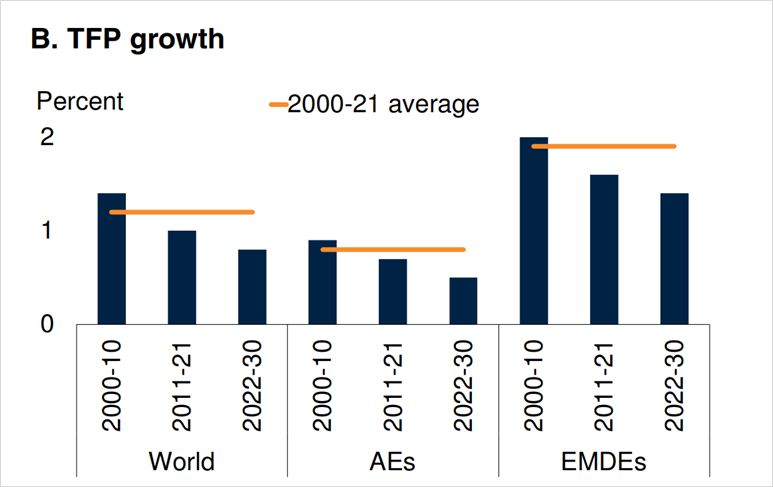Slower Growth Forever?
March 28, 2023
Read Time 2 MIN
Hard Landing Concerns
Financial stability jitters appear to be subsiding for now, but the hard landing concerns in developed markets (DM) refuse to go away – the impact of the banking mini-crisis on lending conditions (which have been tightening for some time now) and the deposit flight are partly to blame. One thing that is often obscured by near-term considerations (like the next rate hike or cut) and data noise is the impact of policy decisions on productivity and long-term growth potential. The World Bank issued a very interesting report, which argues (among other things) that policy uncertainty depressed global investments and productivity in the past 10 years (see chart below), dragging potential growth down with it – both in DM and emerging markets (EM). And it’s not just lower potential output per se, it’s a slower rate “at which an economy can grow without igniting inflation”.
EM Productivity Growth
The World Bank expects these trends to continue in the current decade, but we think that EMs might have a fighting chance to escape the negative feedback loop. First, EM policy framework improved a lot since the 2008-09 global financial crisis, arguably reducing policy uncertainty. EMs are also less “allergic” to the very idea of structural reforms. Second, a higher (and stable) share of the working-age population in EM point to a relatively more favorable outlook for domestic savings that can support both investments and productivity growth, potentially compensating for falling savings in aging DMs. “Getting old before getting rich” China adds an element of suspense in the EM case, but India’s growing population and a better demographic profile create a potential counterpoint.
Room for EM Rate Cuts
Back to the present and a near-term policy impact on growth, we have several important central bank meetings in EM this week. Mexico is on the brink of a pause – aided by the more convincing disinflation progress – but “sticky” inflation components signal that a 25bps could be a good idea. The Czech national bank is often considered a testing ground for the anti-inflation battle, with the rapidly slowing domestic demand, a strong currency, and the improving global price backdrop. The market sees Czech rate cuts within the next 3 months – would the central bank indeed turn dovish or confirm that the bar for cuts is high despite weakening growth, just as its Hungarian counterpart did earlier today? EM’s disinflation poster kid – Brazil – is also staying put, with minutes revealing ongoing concerns about the fiscal outlook and its impact on inflation expectations. Stay tuned!
Chart at a Glance: Global Productivity Growth – Can EMs Reverse the Trend?

Source: World Bank.
Note: (AEs) – advanced economies; (EMDEs) – emerging and developing economies.
Related Topics
Related Insights
February 26, 2024
January 04, 2024
October 27, 2023
PMI – Purchasing Managers’ Index: economic indicators derived from monthly surveys of private sector companies. A reading above 50 indicates expansion, and a reading below 50 indicates contraction; ISM – Institute for Supply Management PMI: ISM releases an index based on more than 400 purchasing and supply managers surveys; both in the manufacturing and non-manufacturing industries; CPI – Consumer Price Index: an index of the variation in prices paid by typical consumers for retail goods and other items; PPI – Producer Price Index: a family of indexes that measures the average change in selling prices received by domestic producers of goods and services over time; PCE inflation – Personal Consumption Expenditures Price Index: one measure of U.S. inflation, tracking the change in prices of goods and services purchased by consumers throughout the economy; MSCI – Morgan Stanley Capital International: an American provider of equity, fixed income, hedge fund stock market indexes, and equity portfolio analysis tools; VIX – CBOE Volatility Index: an index created by the Chicago Board Options Exchange (CBOE), which shows the market's expectation of 30-day volatility. It is constructed using the implied volatilities on S&P 500 index options.; GBI-EM – JP Morgan’s Government Bond Index – Emerging Markets: comprehensive emerging market debt benchmarks that track local currency bonds issued by Emerging market governments; EMBI – JP Morgan’s Emerging Market Bond Index: JP Morgan's index of dollar-denominated sovereign bonds issued by a selection of emerging market countries; EMBIG - JP Morgan’s Emerging Market Bond Index Global: tracks total returns for traded external debt instruments in emerging markets.
The information presented does not involve the rendering of personalized investment, financial, legal, or tax advice. This is not an offer to buy or sell, or a solicitation of any offer to buy or sell any of the securities mentioned herein. Certain statements contained herein may constitute projections, forecasts and other forward looking statements, which do not reflect actual results. Certain information may be provided by third-party sources and, although believed to be reliable, it has not been independently verified and its accuracy or completeness cannot be guaranteed. Any opinions, projections, forecasts, and forward-looking statements presented herein are valid as the date of this communication and are subject to change. The information herein represents the opinion of the author(s), but not necessarily those of VanEck.
Investing in international markets carries risks such as currency fluctuation, regulatory risks, economic and political instability. Emerging markets involve heightened risks related to the same factors as well as increased volatility, lower trading volume, and less liquidity. Emerging markets can have greater custodial and operational risks, and less developed legal and accounting systems than developed markets.
All investing is subject to risk, including the possible loss of the money you invest. As with any investment strategy, there is no guarantee that investment objectives will be met and investors may lose money. Diversification does not ensure a profit or protect against a loss in a declining market. Past performance is no guarantee of future performance.
PMI – Purchasing Managers’ Index: economic indicators derived from monthly surveys of private sector companies. A reading above 50 indicates expansion, and a reading below 50 indicates contraction; ISM – Institute for Supply Management PMI: ISM releases an index based on more than 400 purchasing and supply managers surveys; both in the manufacturing and non-manufacturing industries; CPI – Consumer Price Index: an index of the variation in prices paid by typical consumers for retail goods and other items; PPI – Producer Price Index: a family of indexes that measures the average change in selling prices received by domestic producers of goods and services over time; PCE inflation – Personal Consumption Expenditures Price Index: one measure of U.S. inflation, tracking the change in prices of goods and services purchased by consumers throughout the economy; MSCI – Morgan Stanley Capital International: an American provider of equity, fixed income, hedge fund stock market indexes, and equity portfolio analysis tools; VIX – CBOE Volatility Index: an index created by the Chicago Board Options Exchange (CBOE), which shows the market's expectation of 30-day volatility. It is constructed using the implied volatilities on S&P 500 index options.; GBI-EM – JP Morgan’s Government Bond Index – Emerging Markets: comprehensive emerging market debt benchmarks that track local currency bonds issued by Emerging market governments; EMBI – JP Morgan’s Emerging Market Bond Index: JP Morgan's index of dollar-denominated sovereign bonds issued by a selection of emerging market countries; EMBIG - JP Morgan’s Emerging Market Bond Index Global: tracks total returns for traded external debt instruments in emerging markets.
The information presented does not involve the rendering of personalized investment, financial, legal, or tax advice. This is not an offer to buy or sell, or a solicitation of any offer to buy or sell any of the securities mentioned herein. Certain statements contained herein may constitute projections, forecasts and other forward looking statements, which do not reflect actual results. Certain information may be provided by third-party sources and, although believed to be reliable, it has not been independently verified and its accuracy or completeness cannot be guaranteed. Any opinions, projections, forecasts, and forward-looking statements presented herein are valid as the date of this communication and are subject to change. The information herein represents the opinion of the author(s), but not necessarily those of VanEck.
Investing in international markets carries risks such as currency fluctuation, regulatory risks, economic and political instability. Emerging markets involve heightened risks related to the same factors as well as increased volatility, lower trading volume, and less liquidity. Emerging markets can have greater custodial and operational risks, and less developed legal and accounting systems than developed markets.
All investing is subject to risk, including the possible loss of the money you invest. As with any investment strategy, there is no guarantee that investment objectives will be met and investors may lose money. Diversification does not ensure a profit or protect against a loss in a declining market. Past performance is no guarantee of future performance.

